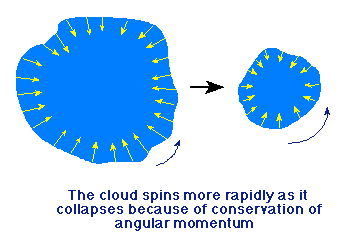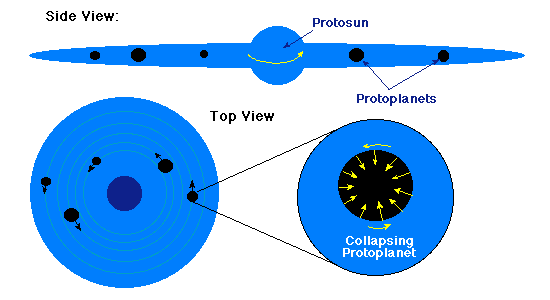
 |
Freethought & Rationalism ArchiveThe archives are read only. |
|
|
#1 |
|
Senior Member
Join Date: Nov 2001
Location: Ecuador
Posts: 738
|
Lil requested that I provide a naturalistic explanation of the origin of Earth. Although I�m more than half convinced this entire effort is a waste of time, I don�t want to be accused of reneging. Any of you out there that would like to add something to the explanation, please feel free to jump in.
All right, Lil. Here�s an explanation for the origin of the solar system and Earth. Since I originally put it together for my ten-year-old daughter, theoretically you should understand it. Our solar system formed about 5 billion years ago from an enormous interstellar cloud of dust and gas (mostly hydrogen), a nebula. These stellar nurseries are abundant in the arms of spiral galaxies like the Milky Way. In the stellar nursery, dense parts of the clouds undergo gravitational collapse and compress to form a rotating gas globule.  As the cloud collapses, it heats up and compresses in the center. It heats enough for the dust to vaporize. The initial collapse is supposed to take less than 100,000 years. The center compresses enough to become a protostar and the rest of the gas orbits/flows around it. Most of that gas flows inward and adds to the mass of the forming star, but the gas is rotating (from the law of conservation of angular momentum). The centrifugal force from the rotation prevents some of the gas from reaching the forming star. Instead, it forms an "accretion disk" around the star. The disk radiates away its energy and cools off.  As the collapse proceeds, the temperature and pressure within the globule increases, as gravity forces the atoms closer and closer together. Also, the globule rotates faster and faster. This spinning action causes an increase in centrifugal forces (a outward force on spinning objects) that causes the globule to have a central core and a surrounding flattened disk of dust (called a protoplanetary disk or accretion disk). The central core becomes the star; the protoplanetary disk may eventually coalesce into orbiting planets, asteroids, etc. Astronomers see these disks, in various stages of formation, all over the observable universe. In fact, it is so common that it is estimated that a new star is formed about once a month in our galaxy alone � and may be forming once a second universe-wide. The contracting cloud heats up due to friction and forms a glowing protostar; this stage lasts for roughly 50 million years. If there is enough material in the protostar, the gravitational collapse and the heating continue. When a temperature of about 27,000,000�F is reached, nuclear fusion begins at the core of the Sun. This is the nuclear reaction in which hydrogen atoms are converted to helium atoms plus energy. This energy (radiation) production prevents further contraction of the Sun. A Star is born.  The disk of gas surrounding the new sun cools off enough for the metal, rock and (far enough from the forming star) ice to condense out into tiny particles. (i.e. some of the gas turns back into dust). The metals condense almost as soon as the accretion disk forms (4.55-4.56 billion years ago according to isotope measurements of certain meteors); the rock condenses a bit later (between 4.4 and 4.55 billion years ago). The dust particles collide with each other and form into larger particles. This goes on until the particles get to the size of boulders or small asteroids. The disk then enters a period of runaway growth. Once the larger of these particles get big enough to have a nontrivial gravity, their growth accelerates. Their gravity (even if it's very small) gives them an edge over smaller particles; it pulls in more, smaller particles, and very quickly, the large objects have accumulated all of the solid matter close to their own orbit. How big they get depends on their distance from the star and the density and composition of the protoplanetary nebula. In the solar system, the theories say that this is large asteroid to lunar size in the inner solar system, and one to fifteen times the Earth�s size in the outer solar system. There would have been a big jump in size somewhere between the current orbits of Mars and Jupiter: the energy from the Sun would have kept ice a vapor at closer distances, so the solid, accretable matter would become much more common beyond a critical distance from the Sun. The accretion of these "planetesimals" is believed to take a few hundred thousand to about twenty million years, with the outermost taking the longest to form. At about this time, about 1 million years after the nebula cooled, the star would generate a very strong solar wind, which would sweep away all of the gas left in the protoplanetary nebula. If a protoplanet was large enough, soon enough, its gravity would pull in the nebular gas, and it would become a gas giant. If not, it would remain a rocky or icy body. At this point, the solar system is composed only of solid, protoplanetary bodies and gas giants. The "planetesimals" would slowly collide with each other and become more massive. Eventually, after ten to a hundred million years, you end up with ten or so planets, in stable orbits, and that's a solar system. These planets and their surfaces may be heavily modified by the last, big collisions they experience (e.g. the largely metal composition of Mercury � and Earth). Because of the original angular momentum and subsequent evolution of the collapsing nebula, this hypothesis provides a natural explanation for some basic facts about the Solar System: the orbits of the planets lie nearly in a plane with the sun at the center, the planets all revolve in the same direction, and the planets mostly rotate in the same direction with rotation axes nearly perpendicular to the orbital plane. The composition of all the planets and moons in our solar system is consistent with this hypothesis! If you want more information, a more technical description can be found <a href="http://pasadena.wr.usgs.gov/office/ganderson/es10/letctures/lecture03/lecture03.html" target="_blank">here</a>. Last chance Lil. |
|
|
|
|
#2 |
|
Junior Member
Join Date: Sep 2000
Location: Louisville
Posts: 7
|
I love fairly tales. I always love pure speculation.
You know what else is funny ...When Nasa first designed a ship to go to the moon, they thought (because of their evolution beliefs)their was going to be several feet of dust. When they got there..they found about 2 inches. |
|
|
|
|
#3 |
|
Banned
Join Date: Sep 2000
Location: Nova Scotia, Canada
Posts: 1,258
|
Originally posted by Wow:
I love fairly tales. I always love pure speculation. Is that why you worship the bible? You know what else is funny ...When Nasa first designed a ship to go to the moon, they thought (because of their evolution beliefs)their was going to be several feet of dust. When they got there..they found about 2 inches. What a load. What does evolutionary beliefs have to do with the Moon or how planetary systems are formed? [ December 29, 2001: Message edited by: Orpheous99 ]</p> |
|
|
|
|
#4 | |
|
Banned
Join Date: Feb 2001
Location: Deployed to Kosovo
Posts: 4,314
|
Quote:
|
|
|
|
|
|
#5 |
|
Senior Member
Join Date: Nov 2001
Location: Ecuador
Posts: 738
|
Wow
Thank you for your inane comment and cogent refutation of my post. Just which part do you consider a "fairy tale"? And btw: origin of the solar system and earth/moon system has absolutely NOTHING to do with evolution. If you'd care to challenge me on that one, I'd be happy to respond. Now I will confess I left out a LOT of the technical physics, astrophysics, cosmology, astronomy, etc. It was, after all, written for a smart pre-teen. Throwing in the equations for gravitational attraction, mass-energy, etc, might have been a bit much. Too bad you didn't understand even this much; my 10-year-old did. |
|
|
|
|
#6 | |
|
Regular Member
Join Date: Feb 2001
Location: Australia
Posts: 226
|
Quote:
 "In 1965, a conference was held on the nature of the lunar surface. The basic conclusion of this conference was that both from the optical properties of the scattering of sunlight observed from the Earth, and from the early Ranger photographs, there was no evidence for an extensive dust layer." (Shore, 1984, p.34) As you can see, the idea that there would be a thick layer of dust was pure speculation (but you love that kinda stuff, right?), and it was concluded that there was no evidence for it at all. |
|
|
|
|
|
#7 | |
|
Veteran Member
Join Date: Mar 2001
Location: Louisville, KY, USA
Posts: 1,840
|
Wow said:
Quote:
[ December 29, 2001: Message edited by: ps418 ]</p> |
|
|
|
|
|
#8 | |
|
Veteran Member
Join Date: Jul 2000
Location: USA
Posts: 5,393
|
Quote:
Rick [ December 29, 2001: Message edited by: rbochnermd ]</p> |
|
|
|
|
|
#9 | |
|
Veteran Member
Join Date: Mar 2001
Location: Cambridge, England, but a Scot at heart
Posts: 2,431
|
Quote:
|
|
|
|
|
|
#10 | |
|
Veteran Member
Join Date: Feb 2001
Location: WI
Posts: 4,357
|
Quote:
|
|
|
|
| Thread Tools | Search this Thread |
|